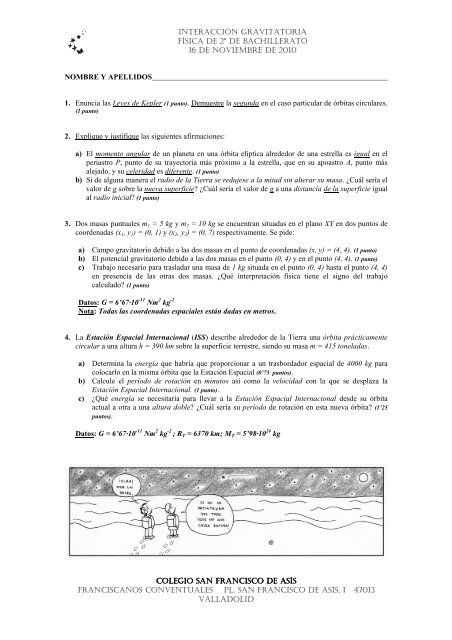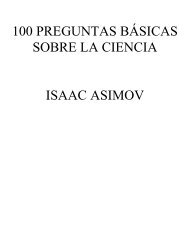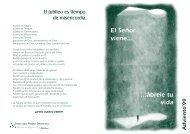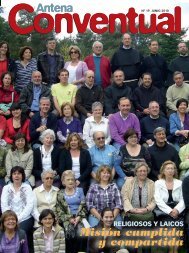interacción gravitatoria física de 2º de bachillerato 16 de noviembre ...
interacción gravitatoria física de 2º de bachillerato 16 de noviembre ...
interacción gravitatoria física de 2º de bachillerato 16 de noviembre ...
You also want an ePaper? Increase the reach of your titles
YUMPU automatically turns print PDFs into web optimized ePapers that Google loves.
INTERACCIÓN GRAVITATORIA<br />
FÍSICA DE <strong>2º</strong> DE BACHILLERATO<br />
<strong>16</strong> DE NOVIEMBRE DE 2010<br />
NOMBRE Y APELLIDOS______________________________________________________________<br />
1. Enuncia las Leyes <strong>de</strong> Kepler (1 punto). Demuestre la segunda en el caso particular <strong>de</strong> órbitas circulares.<br />
(1 punto)<br />
2. Explique y justifique las siguientes afirmaciones:<br />
a) El momento angular <strong>de</strong> un planeta en una órbita elíptica alre<strong>de</strong>dor <strong>de</strong> una estrella es igual en el<br />
periastro P, punto <strong>de</strong> su trayectoria más próximo a la estrella, que en su apoastro A, punto más<br />
alejado, y su celeridad es diferente. (1 punto)<br />
b) Si <strong>de</strong> alguna manera el radio <strong>de</strong> la Tierra se redujese a la mitad sin alterar su masa. ¿Cuál sería el<br />
valor <strong>de</strong> g sobre la nueva superficie? ¿Cuál sería el valor <strong>de</strong> g a una distancia <strong>de</strong> la superficie igual<br />
al radio inicial? (1 punto)<br />
3. Dos masas puntuales m1 = 5 kg y m2 = 10 kg se encuentran situadas en el plano XY en dos puntos <strong>de</strong><br />
coor<strong>de</strong>nadas (x1, y1) = (0, 1) y (x2, y2) = (0, 7) respectivamente. Se pi<strong>de</strong>:<br />
a) Campo gravitatorio <strong>de</strong>bido a las dos masas en el punto <strong>de</strong> coor<strong>de</strong>nadas (x, y) = (4, 4). (1 punto)<br />
b) El potencial gravitatorio <strong>de</strong>bido a las dos masas en el punto (0, 4) y en el punto (4, 4). (1 punto)<br />
c) Trabajo necesario para trasladar una masa <strong>de</strong> 1 kg situada en el punto (0, 4) hasta el punto (4, 4)<br />
en presencia <strong>de</strong> las otras dos masas. ¿Qué interpretación <strong>física</strong> tiene el signo <strong>de</strong>l trabajo<br />
calculado? (1 punto)<br />
Datos: G = 6’67·10 -11 Nm 2 kg -2<br />
Nota: Todas las coor<strong>de</strong>nadas espaciales están dadas en metros.<br />
4. La Estación Espacial Internacional (ISS) <strong>de</strong>scribe alre<strong>de</strong>dor <strong>de</strong> la Tierra una órbita prácticamente<br />
circular a una altura h = 390 km sobre la superficie terrestre, siendo su masa m = 415 toneladas.<br />
a) Determina la energía que habría que proporcionar a un trasbordador espacial <strong>de</strong> 4000 kg para<br />
colocarlo en la misma órbita que la Estación Espacial (0’75 puntos).<br />
b) Calcule el período <strong>de</strong> rotación en minutos así como la velocidad con la que se <strong>de</strong>splaza la<br />
Estación Espacial Internacional. (1 punto).<br />
c) ¿Qué energía se necesitaría para llevar a la Estación Espacial Internacional <strong>de</strong>s<strong>de</strong> su órbita<br />
actual a otra a una altura doble? ¿Cuál sería su período <strong>de</strong> rotación en esta nueva órbita? (1’25<br />
puntos).<br />
Datos: G = 6’67·10 -11 Nm 2 kg -2 ; RT = 6370 km; MT = 5’98·10 24 kg<br />
COLEGIO COLEGIO SAN SAN FRANCISCO FRANCISCO DE DE ASÍS<br />
ASÍS<br />
FRANCISCANOS CONVENTUALES PL. SAN FRANCISCO DE ASÍS, 1 47013<br />
VALLADOLID
SOLUCIÓN:<br />
INTERACCIÓN GRAVITATORIA<br />
FÍSICA DE <strong>2º</strong> DE BACHILLERATO<br />
<strong>16</strong> DE NOVIEMBRE DE 2010<br />
1. (2 puntos)<br />
1ª Ley o Ley <strong>de</strong> las Órbitas: Los planetas <strong>de</strong>scriben órbitas elípticas alre<strong>de</strong>dor <strong>de</strong>l Sol, estando<br />
situado este en uno <strong>de</strong> sus focos.<br />
2ª Ley o Ley <strong>de</strong> las Áreas: El radiovector dirigido <strong>de</strong>s<strong>de</strong> el Sol a los planetas recorre áreas iguales en<br />
tiempos iguales:<br />
dA 1 <br />
= r ∧ v = cte<br />
dt 2<br />
.<br />
3ª Ley o Ley <strong>de</strong> los Períodos: Los cuadrados <strong>de</strong>l periodo <strong>de</strong> revolución <strong>de</strong> los planetas alre<strong>de</strong>dor <strong>de</strong>l<br />
Sol, T, son proporcionales a los cubos <strong>de</strong> los semiejes mayores, o radios medios <strong>de</strong> sus órbitas r: T 2 =<br />
k·r 3 . Don<strong>de</strong> k es una constante igual para todos los planetas que <strong>de</strong>pen<strong>de</strong> <strong>de</strong> la masa <strong>de</strong>l Sol.<br />
DEMOSTRACIÓN DE LA LEY DE LAS ÁREAS: Toda partícula que se mueve bajo la acción <strong>de</strong><br />
<br />
una fuerza central tiene momento cinético constante, L = cte<br />
cumple la ley <strong>de</strong> las áreas: Supongamos que la partícula tarda<br />
un tiempo t en pasar <strong>de</strong> P a P’, el vector <strong>de</strong> posición ha barrido<br />
en este tiempo el área A. Esta<br />
superficie, para un tiempo<br />
pequeño dt, viene a ser la <strong>de</strong> un<br />
triángulo, en el que ds equivale a<br />
un arco <strong>de</strong> circunferencia. El área<br />
<strong>de</strong> este triángulo es:<br />
, y por ser constante en módulo se<br />
1 1 1 2 2<br />
dA = ds ⋅ r = d θr ⋅ r = r ⋅d θ ⇒ r d θ = 2dA<br />
2 2 2<br />
El área barrida está relacionada con el módulo <strong>de</strong>l momento cinético <strong>de</strong> la siguiente forma:<br />
<br />
<br />
ds d θ 2 d θ dA<br />
L = r ⋅mv ⋅ sen ( r , v ) = r ⋅mv ⋅ sen 90º = rmv = rm = rm ⋅ ⋅ r = mr = 2 ⋅m ⇒<br />
dt dt dt dt<br />
<br />
Si L = cte<br />
<br />
dA L<br />
⇒ =<br />
dt 2m<br />
dA<br />
= cte . Por tanto, las áreas barridas en tiempos iguales son iguales. El término<br />
dt<br />
dA<br />
dt recibe el nombre <strong>de</strong> velocidad areolar.<br />
2. Comencemos:<br />
a) Las fuerzas <strong>gravitatoria</strong>s son fuerzas centrales, su dirección es la <strong>de</strong>l<br />
radio, por tanto el momento <strong>de</strong> estas fuerzas respecto al centro (estrella)<br />
es nulo y su momento angular constante: (0’5 puntos)<br />
<br />
<br />
dL <br />
M = r ∧ F, r || F ⇒ M = 0 y M = ⇒ L = cte → L = L<br />
dt<br />
a p<br />
COLEGIO COLEGIO SAN SAN FRANCISCO FRANCISCO DE DE ASÍS<br />
ASÍS<br />
FRANCISCANOS CONVENTUALES PL. SAN FRANCISCO DE ASÍS, 1 47013<br />
VALLADOLID
Por otro lado, (0’5 puntos)<br />
INTERACCIÓN GRAVITATORIA<br />
FÍSICA DE <strong>2º</strong> DE BACHILLERATO<br />
<strong>16</strong> DE NOVIEMBRE DE 2010<br />
<br />
L = L ⇒ L = L → r mv = r mv → r v = r v y como r > r ⇒ v < v , diferente.<br />
a p a p a a p p a a p p a p a p<br />
b) Calculamos el nuevo valor <strong>de</strong>l campo gravitatorio, g’, en función <strong>de</strong>l que suponemos conocido g:<br />
M M M<br />
g = G → g ' = G = 4G = 4g<br />
2 2<br />
2<br />
RT ⎛ R R<br />
T ⎞<br />
T<br />
⎜ 2 ⎟<br />
⎝ ⎠<br />
El valor <strong>de</strong>l campo gravitatorio será cuatro veces mayor que el actual, sobre el planeta hipotético.<br />
(0’5 puntos)<br />
Ahora calculamos el valor <strong>de</strong>l campo gravitatorio a una distancia <strong>de</strong> la superficie (h, altura) igual al<br />
radio inicial (RT), es <strong>de</strong>cir una distancia al centro <strong>de</strong>l planeta igual al radio reducido <strong>de</strong> la Tierra<br />
(RT/2, la mitad <strong>de</strong>l radio inicial) más el radio inicial (RT):<br />
R R 3R M 4 M 4<br />
r = + h = + R = ⇒ g ' = G = G = g<br />
T T T<br />
2 2<br />
T<br />
2 ⎛3RT 2<br />
⎞ 9<br />
2<br />
RT<br />
9<br />
⎜ 2 ⎟<br />
⎝ ⎠<br />
El valor <strong>de</strong>l campo gravitatorio será cuatro novenos que el actual, sobre el planeta hipotético. (0’5<br />
puntos)<br />
M <br />
g = −G<br />
u (1 punto)<br />
r<br />
3. a) El campo gravitatorio que ejerce una partícula tiene la forma: 2 r<br />
6 m<br />
El campo que genera la primera masa es:<br />
m2<br />
m1<br />
r2<br />
r1<br />
4 m<br />
α<br />
g1<br />
g2<br />
P(4,4)<br />
El campo que genera la segunda masa es:<br />
<br />
M <br />
g2 = g2 x + g2 y = − g2 cos αi + g2senα j = G ( − cos αi + senα j)<br />
=<br />
2<br />
r<br />
11 2 2 10kg<br />
<br />
− −<br />
= 6'67 ⋅10 Nm kg ( − cos36'87 i + sen36'87 j)<br />
=<br />
2<br />
(5 m)<br />
<br />
−11 −11<br />
= ( −2'134 ⋅ 10 i + 1'601⋅10 j) N / kg<br />
Finalmente, el campo gravitatorio total en el punto (4, 4) es:<br />
3<br />
tgα = → α = 36'87º; r1 =<br />
4<br />
2 2<br />
3 + 4 m = 5m<br />
<br />
g1 = g1x + g1y M <br />
= −g1 cos αi − g1senα j = − G (cos αi + senα j)<br />
=<br />
2<br />
r<br />
11 2 2 5kg<br />
<br />
− −<br />
= −6'67 ⋅ 10 Nm kg (cos36'87 i + sen36'87 j)<br />
=<br />
2<br />
(5 m)<br />
<br />
−11 −12<br />
= ( −1'067 ⋅10 i −8'004 ⋅10<br />
j) N / kg<br />
COLEGIO COLEGIO SAN SAN FRANCISCO FRANCISCO DE DE ASÍS<br />
ASÍS<br />
FRANCISCANOS CONVENTUALES PL. SAN FRANCISCO DE ASÍS, 1 47013<br />
VALLADOLID
INTERACCIÓN GRAVITATORIA<br />
FÍSICA DE <strong>2º</strong> DE BACHILLERATO<br />
<strong>16</strong> DE NOVIEMBRE DE 2010<br />
<br />
<br />
−11 −12 −11 −11<br />
gT = g1 + g2 = ( −1'067 ⋅10 i −8'004 ⋅ 10 j) N / kg + ( −2'134 ⋅ 10 i + 1'601⋅ 10 j) N / kg =<br />
<br />
−11 −12<br />
= ( −3'201⋅ 10 i + 8'006 ⋅10<br />
j) N / kg<br />
b) (1 punto)<br />
m m ⎛ 5kg 10kg<br />
⎞<br />
1 2<br />
−11 2 −2 −10<br />
V(0,4) = V1(0,4) + V2(0,4) = −G − G = −6'67 ⋅ 10 Nm kg ⎜ + ⎟ = −3'335⋅10 J / kg<br />
r1(0,4) r2(0,4) ⎝ 3m 3m<br />
⎠<br />
m m ⎛ 5kg 10kg<br />
⎞<br />
1 2<br />
−11 2 −2 −10<br />
V(4,4) = V1(4,4) + V2(4,4) = −G − G = −6'67 ⋅ 10 Nm kg ⎜ + ⎟ = −2'001⋅10 J / kg<br />
r1(4,4) r2(4,4) ⎝ 5m 5m<br />
⎠<br />
a) El trabajo para trasladar la carga se pue<strong>de</strong> calcular mediante el incremento <strong>de</strong> energía potencial: (1<br />
punto)<br />
W(0,4) (4,4) = Ep(0,4) – Ep(4,4) = mV(0,4) – mV(4,4) = 1kg·(-3’335·10 -10 + 2’001·10 -10 )J/kg = -1’334·10 -10 J<br />
El trabajo tiene signo negativo, es <strong>de</strong>cir, es un trabajo que hay que realizar sobre la partícula para<br />
que aumente su energía potencial.<br />
4. Comencemos:<br />
a) El radio <strong>de</strong> la órbita por la que circula la estación espacial es h = 390 km r = RT + h = 6370 km +<br />
390 km = 6760 km = 6’76·10 6 m. (0’25 puntos)<br />
Pi<strong>de</strong> calcular la energía <strong>de</strong> satelización <strong>de</strong>l trasbordador: (0’5 puntos)<br />
Mm Mm ⎛ Mm ⎞ ⎛ 1 1 ⎞<br />
Ec0 = Ecf + Epf − Ep 0 = G − G − ⎜ − G ⎟ = GMm⎜<br />
− ⎟ ⇒<br />
2r r ⎝ R ⎠ ⎝ R 2r<br />
⎠<br />
2<br />
−11<br />
Nm<br />
24 3 ⎛ 1 1 ⎞<br />
11<br />
⇒ Δ E = 6'67 ⋅10 ⋅5'98 ⋅10 kg ⋅ 4'000 ⋅10 kg ⋅ 1'32 10 J<br />
2 ⎜ − 6 6 ⎟ = ⋅<br />
kg ⎝ 6'370 ⋅10 m 2⋅ 6'76 ⋅10<br />
m ⎠<br />
b) Sabemos que el radio <strong>de</strong> la órbita por la que circula la estación espacial es h = 390 km r = RT + h<br />
= 6370 km + 390 km = 6760 km = 6’76·10 6 m.<br />
Calculamos la velocidad <strong>de</strong> un cuerpo en una órbita alre<strong>de</strong>dor <strong>de</strong> la Tierra igualando la fuerza<br />
centrífuga a la <strong>de</strong> atracción <strong>gravitatoria</strong>:<br />
g c<br />
2<br />
v Mm M<br />
r<br />
2<br />
r r<br />
F = F → m = G → v = G ⇒<br />
2<br />
−11<br />
Nm<br />
24<br />
5'98⋅10 kg m<br />
2 6<br />
⇒ v = 6'67⋅10 ⋅ = 7681'4<br />
kg 6'76⋅10 m s<br />
El periodo es el tiempo que tarda en dar una vuelta completa:<br />
(0’5 puntos)<br />
COLEGIO COLEGIO SAN SAN FRANCISCO FRANCISCO DE DE ASÍS<br />
ASÍS<br />
FRANCISCANOS CONVENTUALES PL. SAN FRANCISCO DE ASÍS, 1 47013<br />
VALLADOLID
INTERACCIÓN GRAVITATORIA<br />
FÍSICA DE <strong>2º</strong> DE BACHILLERATO<br />
<strong>16</strong> DE NOVIEMBRE DE 2010<br />
6<br />
2π r 2π ⋅6'76 ⋅10<br />
m 1min<br />
T = = = 5529'5s ⋅ ≃ 92 min (0’5 puntos)<br />
v 7681'4 m<br />
60s<br />
s<br />
c) El radio <strong>de</strong> la órbita con altura doble que la inicial será: r = RT + h = 6370 km + 780 km = 7150 km<br />
= 7’15·10 6 m. (0’25 puntos)<br />
La energía <strong>de</strong> una órbita la calculamos como la suma <strong>de</strong> la energía cinética más la potencial:<br />
1 Mm 1 Mm Mm 1 Mm<br />
2 r 2 r r 2 r<br />
2<br />
Eórb = Ec + Ep = mv − G = G − G = − G<br />
Para llevarla <strong>de</strong>s<strong>de</strong> la órbita inicial r0 hasta la final rf el consumo energético es: (0’5 puntos)<br />
1 Mm ⎛ 1 Mm ⎞ Mm ⎛ 1 1 ⎞ Mm ⎛ rf − r ⎞ i<br />
Δ E = Eórb( f ) − Eórb ( i) = − G − ⎜ − G ⎟ = G ⎜ − = G<br />
⇒<br />
2 rf 2 ri 2 ⎜<br />
⎟<br />
ri r ⎟<br />
⎜ ⎟<br />
f 2 ⎜ rr ⎟<br />
⎝ ⎠ ⎝ ⎠ ⎝ i f ⎠<br />
2 24 5 6 6<br />
−11<br />
Nm 5'98 ⋅10 kg ⋅ 4'15 ⋅10 kg ⎛ 7 '15⋅10 − 6'76 ⋅10<br />
⎞<br />
11<br />
⇒ Δ E = 6'67 ⋅10 ⋅ ⋅ 6'68 10 J<br />
2 ⎜ 6 6 ⎟ = ⋅<br />
kg<br />
2 ⎝ 6'76 ⋅10 ⋅7 '15⋅10 ⎠<br />
El periodo <strong>de</strong> rotación en la nueva órbita se calcula a partir <strong>de</strong> la velocidad en la misma:<br />
2 24<br />
−11<br />
Nm 5'98⋅10 kg m<br />
v = 6'67 ⋅10 ⋅ = 7469 ⇒<br />
2 6<br />
kg 7'15⋅10 m s<br />
6<br />
2π r 2π ⋅7'15⋅10 m 1min<br />
⇒ T = = = 6015s ⋅ ≃ 100min<br />
v 7469 m<br />
60s<br />
s<br />
(0’5 puntos)<br />
COLEGIO COLEGIO SAN SAN FRANCISCO FRANCISCO DE DE ASÍS<br />
ASÍS<br />
FRANCISCANOS CONVENTUALES PL. SAN FRANCISCO DE ASÍS, 1 47013<br />
VALLADOLID









